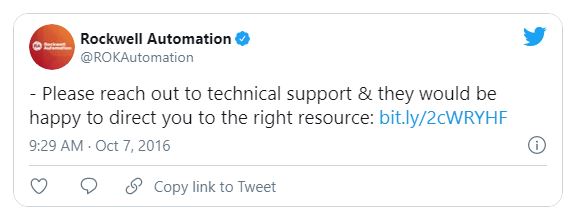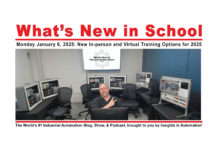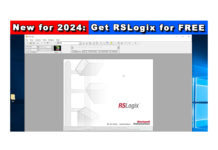
Learning to use PLCs can be frustrating if you don’t know how to get your hands on the actual PLC Programming Software.
So in today’s article I’ll walk through several free options to get various PLC Programming Software packages so you can learn to use and program PLCs right away.
Note: I expect the below list to grow and change over time. If you’d like me to add a vendor to the list, please contact me directly using the Submit A News Tip link.
Article Index:
- Rockwell A-B PLC-5/SLC-500/MicroLogix/RSLogix
- Rockwell A-B Micro800/CCW
- Rockwell A-B Compact/ControlLogix/Studio5000
- Siemens S7-1200/1500/TIA Portal
- Misubishi iQ-F/iQ-R/GXWorks3
- Wago PFC100/PFC200/e!Cockpit
- Additional PLC Vendors
Rockwell Automation (Allen-Bradley, Rockwell Software)
Today there are three different Programmable Controller lines from Rockwell that you can learn by getting a trial copy of the programming software, and I’ll detail each below:
PLC-5, SLC-500, MicroLogix
 If you work in a plant with a lot of legacy products and want to learn how to use them, then you’ll be happy to know that for several years Rockwell has made RSLogix Micro Starter Lite, RSEmulate 500, and RSLinx Classic Lite available as free downloads.
If you work in a plant with a lot of legacy products and want to learn how to use them, then you’ll be happy to know that for several years Rockwell has made RSLogix Micro Starter Lite, RSEmulate 500, and RSLinx Classic Lite available as free downloads.
While the free RSLogix Micro Starter Lite can only program the MicroLogix 1000 and 1100 controllers, they program almost identically to the rest of the MicroLogix family, as well as the SLC-500 and PLC-5. So in learning RSLogix Micro you’ll also be learning key aspects of the SLC-500 and PLC-5.
Also, most people don’t grasp that with a free copy of RSEmulate 500, you don’t even need a physical PLC as it will emulate your programs right on your PC.
I even include lessons on all three of these free packages (as well on using them with the MicroLogix 1000 and 1100) in my budget friendly course, PLC Basics, which you can pickup a lifetime copy of right now for just $49 here.
You’ll also find my step-by-step article on how to get all three of the above software packages here.
Micro800 (810, 820, 830, 850, 870)
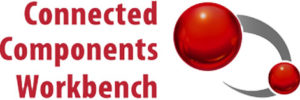 If you’re looking for the newest and most modern “low-cost” Programmable Controller from Rockwell Automation, then what you’re looking for is the Micro800 line.
If you’re looking for the newest and most modern “low-cost” Programmable Controller from Rockwell Automation, then what you’re looking for is the Micro800 line.
This small and cost effective PLC shouldn’t be confused with “smart relays,” as not only are all the Micro800s full fledged PLCs, they also all support Ladder Logic, Function Blocks, and Structured Text programming languages.
One thing that has held back experienced A-B users from using these PLCs is something I actually think is an advantage to new users: The Micro800 programming software doesn’t look or act very much like RSLogix.
While many long time users don’t want to learn a new software package, the simple “standards based” Micro800 programming environment supports three of the IEC-61131 languages, and is in my opinion is a great place to start before going on to more complex development environments like Studio 5000 and TIA Portal.
Best of all, the Micro800’s programming software, Connected Components Workbench (CCW,) is completely free, with the latest versions also including a free Micro850 simulator so users can test out their programs without having to purchase a physical PLC.
Now if you’d like some help getting up to speed with the Micro800 and CCW, I created a low cost course just on this product line, in which I cover programming examples based on real world industrial applications. You can grab a lifetime copy of the course here for just $49, and you can learn how to get a free copy of CCW in my previous article here.
ControlLogix, CompactLogix, RSLogix/Studio 5000
 Learning Rockwell’s premiere line of Programmable Automation Controllers is the goal of many who are looking for PLC Training.
Learning Rockwell’s premiere line of Programmable Automation Controllers is the goal of many who are looking for PLC Training.
But unlike other PLC vendors, Rockwell doesn’t make getting a trial copy of their Studio 5000 Programming and Emulation software as easy as just downloading it from their website.

To get a trial copy you have two options:
First, you can call your local Rockwell distributor (find them here) and ask them for a Thirty Day Temporary Activation (learn more about that here.)
The problem is, while this program has been around for over a dozen years, most distributors don’t know it exists.
If you run into that situation, or you’re located overseas and don’t have a local Rockwell representative, the other option is to contact Rockwell’s Online Activation Support Chat as per Rockwell’s advice to me on social media when I asked them about Temporary Activations:
That said, since I started TheAutomationSchool.com back in 2014, I’ve run into a few challenges actually getting Rockwell to send out a Trial License, and below I’ll cover the four most common:
1) Ask specifically for a “30 Day Temporary Activation” of Studio 5000 Full & Emulate 5000
Studio 5000 Full Edition not only supports all CompactLogix and ControlLogix controllers, it also includes all the programming languages these PACs support, including Ladder, Function Block, Structured Text and Sequential Function Charts.
And if you don’t have CompactLogix or ControlLogix hardware, Emulate 5000 will give you a way to test run your code.
2) Do not tell them you’re a student or “in training”
Sadly, if you tell them this they will typically assume you’re a college student and will refer you to your instructor to buy a 6 month Student toolkit for $200.
That said, just tell them you are requesting a demo copy of the software so you can try it out without going into the details about your goal to become a proficient user of it.
3) Use your name as your company name
Since the folks at Rockwell have to fill in a form which requires a company name be provided, if you tell them you don’t have a company to fill in that spot they will not be able to process your request.
That said, if you don’t feel comfortable using your current employer’s name, keep in mind it’s your right in the USA to use your legal name as your business name. In fact, every US citizen has the right to do business in their own name without the need to register as a business with anyone (we’re also required to report any and all income to the IRS, just like big companies 😉
4) It’s a one time option
The purpose of Rockwell’s Temporary Activations is ostensibly to give new users an opportunity to try their software out, and like other companies that offer trial software, the Rockwell temporary activation will enable the software to work for just thirty calendar days, after which you’ll need to purchase a copy to keep using it.
So if you want to learn how to use Rockwell’s Logix PLCs, given that you’ll only get access to the software for 30 days, you might want to pair it up with my PAC Basics course here which starts at $99. It covers everything you need to know to setup, program, and debug ControlLogix programs used in real world applications.
Siemens:
S7-1200, S7-1500, PLCSim, TIA Portal
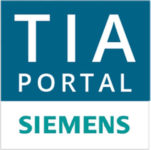 Another premiere Programmable Controller that is quite possibly the most popular PLC world-wide is the Siemens S7 series.
Another premiere Programmable Controller that is quite possibly the most popular PLC world-wide is the Siemens S7 series.
But unlike Rockwell, Siemens makes it super easy to get a copy of their TIA Portal to try for 21 days.
Just follow the steps in my article here and you’ll not only get 21 Days to try our the Siemens Step 7 programming software, but the TIA Portal trial also includes the S7 PLC Simulator, PLCSim, and the HMI programming software, WinCC.
I’m currently working on courses covering both the S7-1200 and S7-1500, but until they’re released you can check out my past coverage here, including how to write your first program for each PLC using TIA Portal.
Before I move on to the next category, I just wanted to send out a special thanks to the good folks at Siemens for all their support!
Not only have the samples that’ve sent in allowed us to cover their products, their advertising support of TheAutomationBlog.com has helped keep us online through some very trying times.
Mitsubishi:
iQ-R, iQ-F, GXWorks3
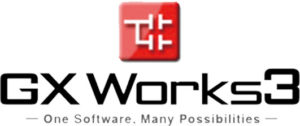 Another world leader in Programmable Controllers is Mitsubishi.
Another world leader in Programmable Controllers is Mitsubishi.
If you’re not familiar with their PLCs, you can get up to speed in episode 48A and 48B of The Automation Podcast where I sit down with them to get a complete overview of their PLC product lines.
As far as getting a trial of their GX Works3 PLC Programming Software, this link brings you to a webpage where you can download a 20 day trial copy of the English version.
And thanks to the samples they sent in, you can learn how to use a Mitsubishi controller for the first time (and more) in our previous Mitsubishi coverage here.
Special thanks to Mitsubishi for donating an FX5 and HMI for use on TheAutomationBlog.com.
Wago
PFC100, PFC200, e!Cockpit
 Another company known for it’s industrial automation products is Wago, who offers a range of products including a popular line of distributed I/O and PLCs.
Another company known for it’s industrial automation products is Wago, who offers a range of products including a popular line of distributed I/O and PLCs.
Wago also offers a thirty day trial license of their e!Cockpit PLC programming software which can be downloaded here.
With it, users can program in Ladder Diagram (LD), Function Block Diagram (FBD), Structured Text (ST), Instruction List (IL), Sequential Function Chart (SFC) and Continuous Function Chart (CFC).
If you need a jump start using e!Cockpit, thanks to a donation from Wago I’ve been able to put together the following content covering their PLCs and I/O here.
Additional PLC Vendors
Several of my connections on LinkedIn commented on my last PLC Training article about additional PLC Vendors including Schneider Electric, B&R, Beckoff, Omron, CodeSys, Automation Direct, EZ Automation, and others.
I’ve reached out to these vendors and invited them to come on my podcast to bring us up to speed on their PLC product lines, as well as to let us know of any trial programming software and/or starter packs they may offer.
If any take me up on the offer I’ll be sure to come back and update this article with the new information.
Until then, I want to invite you to become part of our new community at TheAutomationBlog.com/join, as well as wish you all a safe, healthy, and prosperous week!
Until next time, Peace ✌️
If you enjoyed this content, please give it a Like, and consider Sharing a link to it as that is the best way for us to grow our audience, which in turn allows us to produce more content 🙂
Shawn M Tierney
Technology Enthusiast & Content Creator
Support our work and gain access to hundreds members only articles and videos by becoming a member at The Automation Blog or on YouTube. You’ll also find all of my affordable PLC, HMI, and SCADA courses at TheAutomationSchool.com.
- FactoryTalk Design Workbench First Look, CCW Comparison - December 19, 2025
- Drew Allen of Grace Technologies on Automation, Safety, and More (P256) - December 17, 2025
- Robotics in Warehouse Automation with Erik Nieves of Plus One Robotics (P255) - December 10, 2025

Discover more from The Automation Blog
Subscribe to get the latest posts sent to your email.


